Getting the right amount of light for your air plant to thrive can be tricky when you are unsure of its needs.
Do air plants even need light, and if so, how much light do they need?
Air plants need light to live. Tillandsias thrive in bright, filtered light. How much light an air plant needs depends on its type: a mesic (prefer indirect sunlight) or xeric type (prefer bright direct sunlight).
Let’s discuss the role that light plays in the health and lifespan of a Tillandsia. I will also mention where you can where to put air plants.
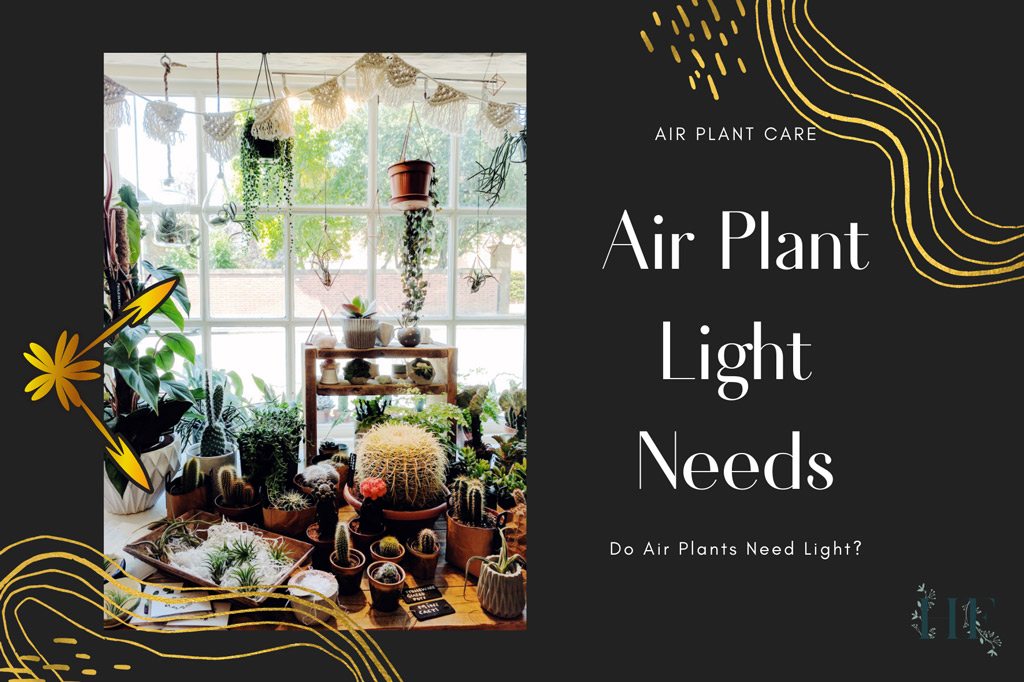
Air Plant Light Needs
There are 3 factors for healthy reproducing air plants: water, light and nutrients.
Do Air Plants Need Light?
Air plants cannot survive without sunlight; they need light to live. Tillandsias thrive in bright, filtered light. Unlike mesic air plants, the xeric type can take direct sunlight.
Generally, you want to keep all of your air plants out of direct sunlight as much as possible. However, some Tillandsias can take more sun than others depending on the species of the air plant and their natural habitat.
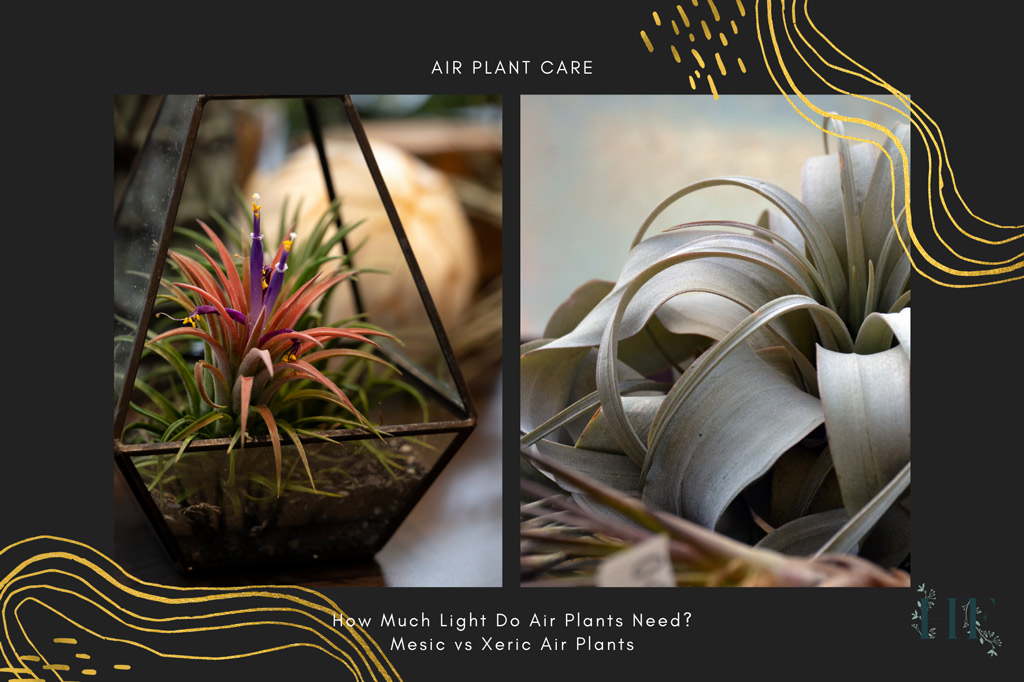
How Much Light Do Air Plants Need?
This part can be tricky because… too little light and your air plant won’t grow. Too much light and you will cremate the plant.
How much light an air plant needs depends on the Tillandsia being a mesic or xeric type, or something in between.
Mesic air plants do better with indirect sunlight. Their natural habitat is the terrestrial shade or in the lower levels of the forests (like South American rainforests), where they receive indirect sunlight. They have smooth green leaves with less visible trichomes.
Xeric air plants prefer bright direct sunlight. These come from drier or dessert-like habitats and mostly live on the upper floors of the woods and on rocks (cliffs), where they are exposed to direct sunlight. They have fuzzy-looking grey or light green leaves with abundant trichomes.
What are trichomes and why are they important?
Air plant leaves are covered in tiny scales, i.e., trichomes, that have two functions:
- Assisting in absorbing water and nutrients.
- Helping to reflect sunlight off the leaf.
Read also: Air Plant Origin and 5 Most Common Tillandsia Varieties – for more about mesic and xeric air plants, and how to differentiate them!
Too Much Light
If your air plant is exposed to too much sunlight, its moisture will get depleted. This can cause them to get sunburn and eventually die if they are left in the sun too long.
Here are the signs of sunburn to beware of:
- Brown or scorched spots.
- Dried out patches or leave tips.
- Discolouration.
If you notice any of these signs, move the air plant to a less sunny location. But before that, you should:
- Trim or pull the damaged leaves.
- Give the air plant a good soaking.
- Do not fertilize the air plant until it is completely healthy again, just continue with your watering schedule and add a few daily, light mistings.
Be patient and consistent and your air plant should get back to its happy, healthy self in no time!
Read also: 13 Common Air Plant Problems, Pests and Diseases – to learn more about how to prevent sunburn (too much light) and other problems.
Too Little Light
On the other side of the spectrum, your air plant could be getting too little light.
If your air plant turns much lighter in colour it’s telling you that it needs more daylight.
An air plant’s light needs are closely related to the environment you place your Tillandsia. The environmental factors that affect your air plant are:
- Light.
- Air.
- Temperature.
- Humidity.
Read also: Air Plant Environment – Light, Temperature, and Humidity Needs.
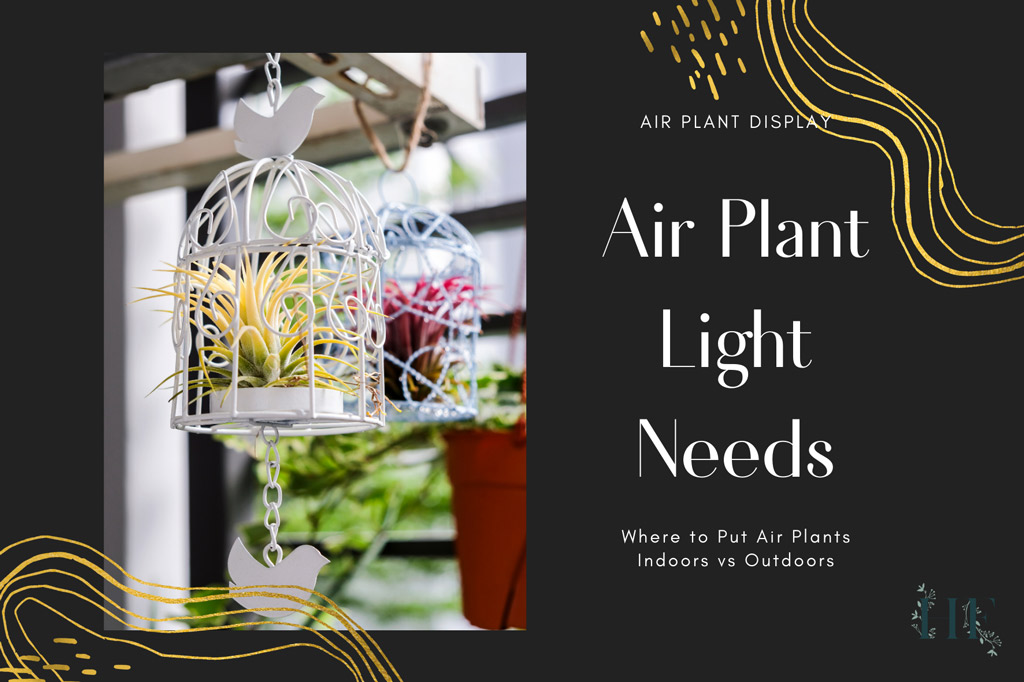
Where to Put Air Plants According to Their Light Needs
It’s worth considering the environment and how you display your Tillandsia.
Air Plants Indoors
If you keep your air plants indoors, keep them close to a window. Xeric air plants can stay on the windowsill. But keep mesic air plants away from direct sunlight, but not too far from the light source either.
Insider Tip: As a rule of thumb for indoor plants, don’t place them more than 10 feet (3m) from a window.
Finding the right spot can be tricky and you need to take into account two things:
- The climate: Where you live, i.e., the climate in your area – humidity and temperature levels.
- Low humidity and high temperatures: In areas that lack humidity, like the desert, your plants will damage and dry out from the direct sunlight even quicker. Xeric types are better suited for this climate.
- High humidity and high temperatures: You need to keep your mesic air plants away from direct sunlight but they will keep moist for longer thanks to the humidity levels.
- Window orientation: From what direction is the light coming from? i.e., the window orientation – south, east, west or north-facing.
- Southern or eastern facing windows: these spaces will be brightly illuminated by the sun for most of the day.
- North-facing windows: these spaces might not get enough light (especially if trees and buildings block the sun) and can get cold in winter.
- West-facing windows: The light tends to come late in the day, and can be very hot and intense. You need to be careful if you don’t want to fry your air plant!
So, you can place your air plant no farther than 10 feet (3m) from a west, east, or south-facing window.
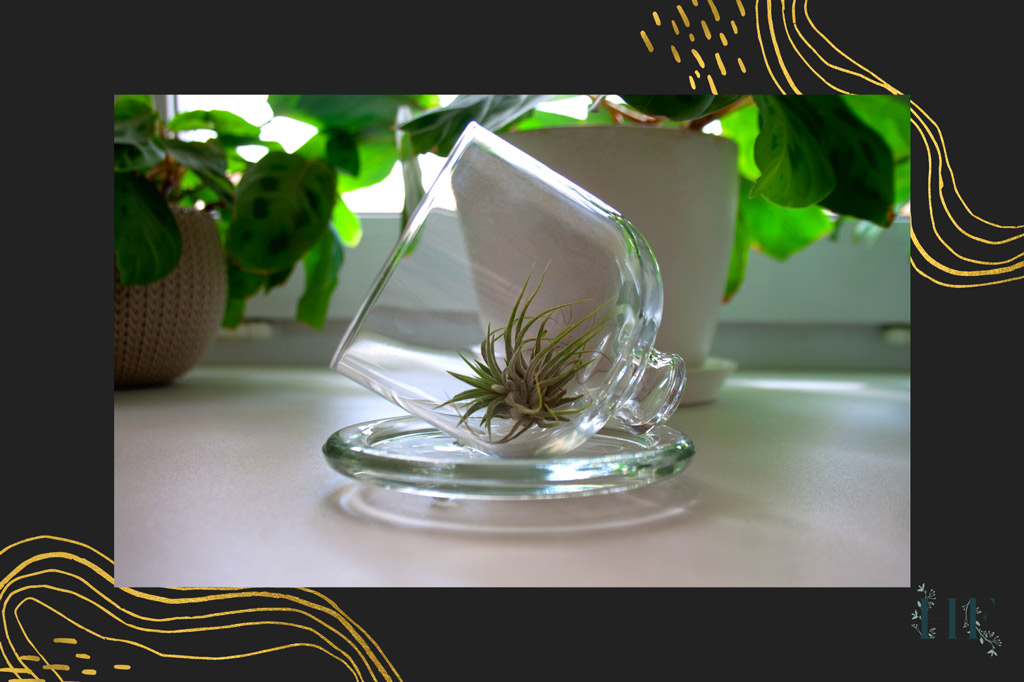
You could also keep your Tillandsia closer to a window that is partly shaded, either from a tree or a building, i.e., any other kind of protection from the direct sun.
The Royal Horticultural Society (RHS) in the U.K. recommends positioning your air plant in a south-facing window behind a net curtain. This advice is especially practical for those who live in the U.K., or a seasonal island.
Personally, I do benefit from the protection that net curtains provide my succulents in both west and east-facing windows in the summertime.
Once you decide where you want to display your air plant, let it acclimate and keep an eye to see how it’s doing.
Read also: 10 Air Plant Display Ideas that Won’t Harm Tillandsias.
Air Plants Outdoors
During the summer months, you can take your air plants outdoors in partially shaded areas. Xeric air plants like T. xerographica and T. Tectorum can take direct sunlight.
If you keep your air plants outdoors, just follow the same guidelines that I gave above. Generally, keep them in an area where the sun won’t directly hit them.
For instance, you can display your air plants outdoors in the following locations:
- Under a tree.
- In a shaded porch or patio.
After your Tillandsias enjoy spending the summer outside, it’s time to move them back indoors before the first frost in autumn occurs (unless you live where that air plant is originally from!)
Read also: Air Plant Care – 8 Steps to Grow and Keep Tillandsias Alive.
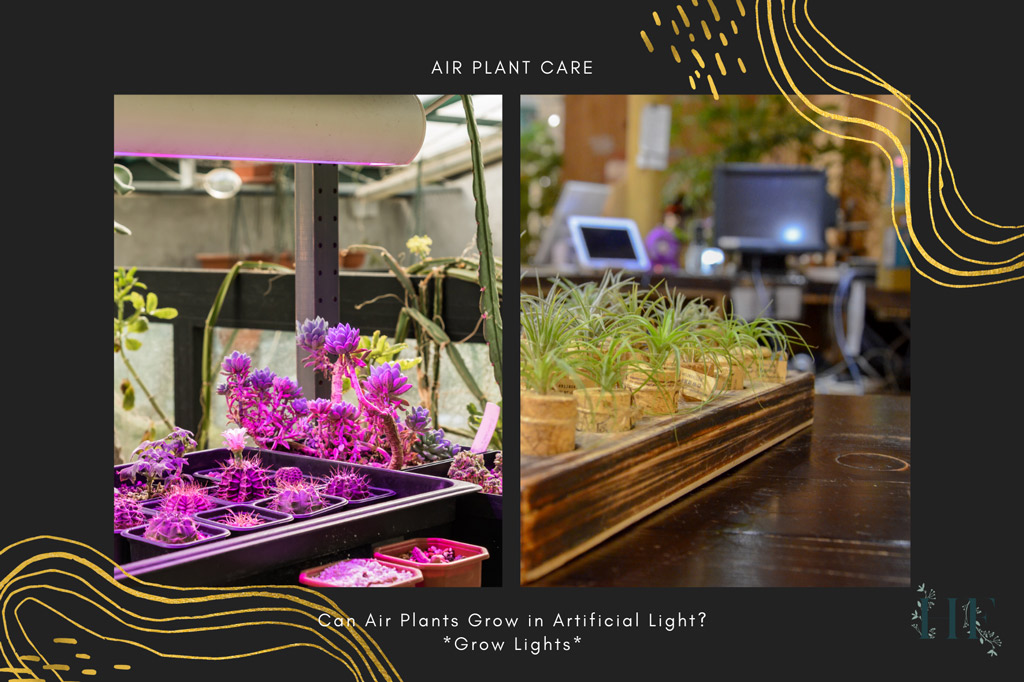
Can Air Plants Grow in Artificial Light?
If your air plant isn’t getting enough light, supplemental lighting via a fluorescent light or a grow light can help.
Air plants can grow in artificial light as well but it must be a full-spectrum fluorescent light. Aim for 12 hours of fluorescent light for air plants to grow, which mimics daylight hours.
You will have to get full-spectrum fluorescent bulbs (grow lights) since the regular incandescent bulbs don’t emit the quality of light these plants need to photosynthesize.
Also, pay attention to the distance between the plant and the artificial light source. The light system should provide you with some guidelines for this.
Check this fluorescent grow light for indoor plants with a full spectrum here, it’s adjustable, you can clip it to a shelf, and it has a timer setting.
Finally, remember that artificial lights produce heat and heat affects the humidity levels of your plant.
P.S. Comment below if you would like to know more about growing air plants with grow light and I will dig around for more info!

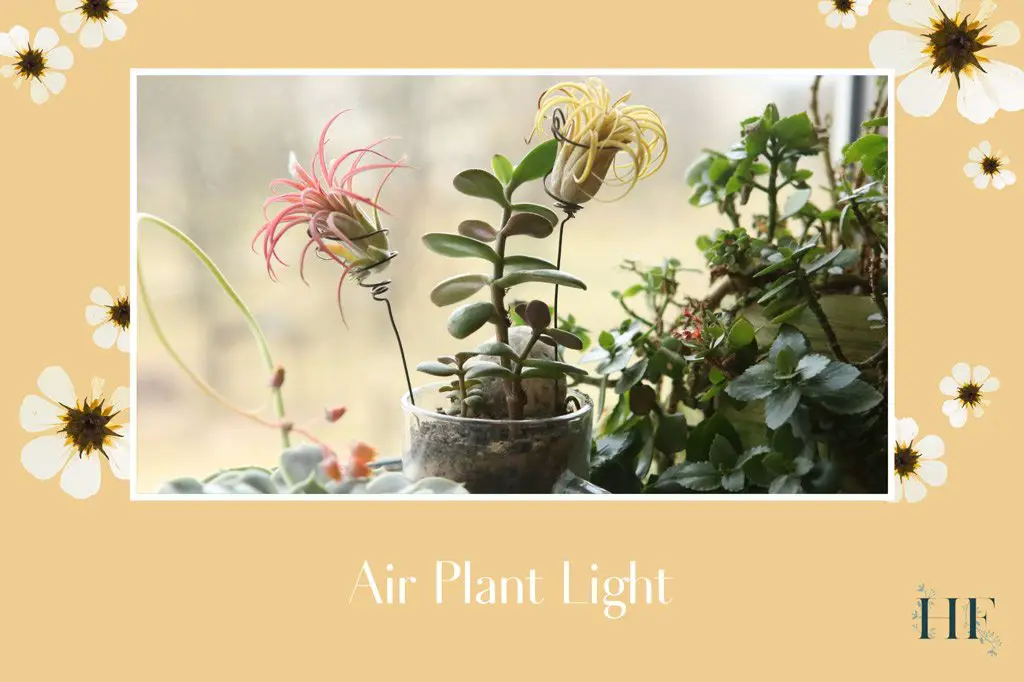
I would be very interested in knowing more about growing air plants with grow lights. Our windows and deck are currently shaded by leafy trees. We get more natural light in the winter time.